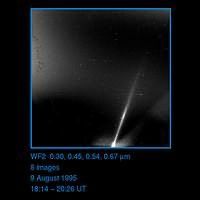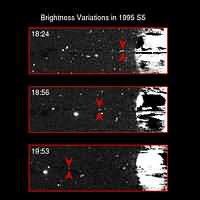1 min read
Saturn’s E Ring in Ultraviolet Light

Visible from Earth only at times of ring plane crossing, Saturn's tenuous E Ring was discovered during the 1966 crossings and imaged again in 1980. From these observations, its color is known to be distinctively blue. The E Ring was captured in ultraviolet light for the first time in this image taken with HST's Wide Field and Planetary Camera on 9 August 1995. Five individual images taken with a broadband 3000 A filter were combined, amounting to a total exposure time of 2200 sec. Shorter exposure images were also obtained with blue, red and infrared filters in order to characterize the ring's color.
The peak brightness of the E Ring occurs at 3.9 Saturn radii (235,000 km), coinciding with the orbit of Enceladus. In the HST images it can be traced out to a maximum distance of approximately 8 Rs (480,000 km). The vertical thickness of the ring, on the other hand, is smallest at Enceladus' orbit, with the ring puffing up noticeably at larger distances to 15,000 km or more thick.
Also visible in this image, between the E Ring and the overexposed outermost part of the main rings near the lower edge of the frame, is the tenuous, thin, 6000 km-wide G Ring at 2.8 Rs (170,000 km). This is among the first earth-based observations of the G Ring, which was discovered by the Pioneer 11 spacecraft in 1979. Noticeably thinner than the E Ring and more neutral in color, the G Ring is thought to be composed of larger, macroscopic particles, and to pose a significant hazard to spacecraft.
The faint diagonal band in the lower right part of the image is due to diffracted light from the heavily-overexposed planet.
- Object NameObject NameA name or catalog number that astronomers use to identify an astronomical object.Saturn
- Release DateAugust 11, 1995
- Science ReleaseHubble Again Views Saturn’s Rings Edge-On
- Credit
Related Images & Videos

Saturn's Rings Edge-on
Saturn's magnificent ring system is seen tilted edge-on - for the second time this year - in this NASA Hubble Space Telescope picture taken on August 10, 1995, when the planet was 895 million miles (1,440 million kilometers) away. Hubble snapped the image as Earth sped back...

Reappearance of Saturn's Satellite Mimas
On 10 August 1995 HST observed the second passage of the Earth through Saturn's ring plane in the 1995/96 series of triple crossings. This pair of 100 sec exposures was taken with the Wide Field and Planetary Camera (WFPC2) in planetary (high resolution) mode 2.5 hours prior to...

Motion of Saturn's Satellites
This sequence of 100 sec exposures taken with HST's Wide Field and Planetary Camera (WFPC2) in planetary mode on 10 August 1995 shows three of the smaller satellites of Saturn, as well as the newly discovered object 1995S5. Epimetheus is the smaller co-orbital satellite and...

Brightness Variations in Saturn's Satellite 1995S5
This sequence of 100 sec exposures taken with HST's Wide Field and Planetary Camera (WFPC2) in planetary mode on 10 August 1995 shows the newly discovered object 1995S5 (red arrows) moving in its orbit around the planet. As it moves further from Saturn, its brightness decreases...
Share
Details
Claire Andreoli
NASA’s Goddard Space Flight Center
Greenbelt, Maryland
claire.andreoli@nasa.gov




























